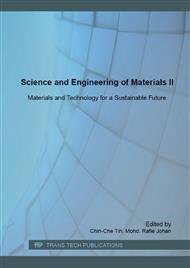p.117
p.122
p.127
p.132
p.138
p.143
p.148
p.154
p.159
Characterization of Raw and Thermally Treated Alum Sludge
Abstract:
Use of alum as a coagulant in drinking water treatment process generates an alum sludge as a waste product. Since the amount of this sludge is huge, it is crucial for a water work management to properly handle and dispose of this sludge. Reuse of this alum sludge as a solid adsorbent is one of the proposed applications for this material but modification and characterization are needed to alter and identify its properties so that optimum benefits are obtained. This paper reports characterization of raw and thermally treated alum sludge. The raw alum sludge was collected from a local water treatment plant and heated at 300 °C and 800 °C for 7 hours using a furnace before characterization using scanning electron microscopy energy (SEM), thermogravimetric (TGA), X-ray diffraction (XRD) and Brunauer-Emmett-Teller (BET). The results showed that surface morphology, thermal properties, microstructure, surface area and porosity of the sludge were affected by heating temperature whereby increase the heating temperature resulted in improved thermal stability of the sludge. The results also revealed that both raw and thermally treated alum sludge were mesoporous materials and mainly compose of quartz and kaolinite. It can be said that the sludge could be a good candidate as low cost adsorbent.
Info:
Periodical:
Pages:
138-142
Citation:
Online since:
July 2016
Keywords:
Price:
Сopyright:
© 2016 Trans Tech Publications Ltd. All Rights Reserved
Share:
Citation:


